As announced last Sunday, I have added the Ivy ETF Portfolio in this line up. It’s indentified as Portfolio #6.
All portfolios held pretty steady during the past 5 trading days, but came off their highs made last Friday, the last day of April. The S&P 500 gained 0.74% for this period.
With a little bit of weakness having set in during the first two trading days of May, especially in the metals, it remains to be seen if this current resistance continues. As far as the 6 portfolios are concerned, your main criteria should be your own risk tolerance when making a decision as to which might be suitable for you.
Let’s review the first one (click on any table to enlarge):
1. ETF Trend Tracking Model Portfolio
This is the portfolio allocation I predominantly use in my advisor practice. Given current market conditions, and an ever growing number of global hotspots, I like the concept of having a solid core holding in PRPFX.
Around this fund, I have added what I call boost components consisting of ETFs that can produce higher returns than my core holding, at least during bullish periods. When a market pullback occurs, the core holding should add an element of stability.
This is exactly what happened early in March, when the double natural disasters struck Japan. While the S&P 500 lost all of its YTD gains, and dropped into negative territory, this portfolio stayed positive.
Nevertheless, as you know from my writings, anything I invest in involves the use of trailing sell stops, which are shown and tracked on the upper right of the table.
Last week, this portfolio was up YTD +7.74% vs. +7.55% as of today.
2. Conservative ETF Growth Portfolio
This portfolio, as are the following ones, would be typical of what is being used in the buy-and-hold community, as you can see by the 40% allocation to various bond ETFs. If you are conservative, this simple combination could work for you, but I still recommend the use of the trailing sell stops during these uncertain times.
Last week, this portfolio was up YTD +5.55% vs. +5.85% as of today.
3. Aggressive ETF Growth Portfolio
What makes this one aggressive is the 15% allocation to bonds. This portfolio is leading the bunch on a YTD basis, because we are in a bullish period. When a correcion occurs, this one will lose value faster than all of the others.
However, if you have an aggressive streak in your personality, you could consider this one. If you use my recommended sell stop discipline, you know exactly ahead of time what your risk will be.
Last week, this portfolio was up YTD +9.06% vs. +9.08% as of today.
4. Moderate ETF Growth Portfolio
I call this one moderate growth, because of the higher allocation to various bond ETFs (26%) than in the aggressive set up above. It is also more diversfied domestically, but as the YTD return shows, that does not seem to matter much as it slightly trails my Trend Tracking Portfolio.
Last week, this portfolio was up YTD +7.54% vs. +7.61% as of today.
5. ETF Income Portfolio
This is as simple as it gets, but in the current market environement, this portfolio still ranks #2, just behind the aggressive version. Howver, when a market set back occurs, this one could drop in value quickly due to no offsetting bond positions. Be sure to use a 7% sell stop on all holdings.
Last week, this portfolio was up YTD +8.28% vs. +9.23% as of today.
6. The Ivy ETF Portfolio
If you missed last Sunday’s post about the Ivy portfolio, you can read it here.
This is a simple 5-asset class portfolio with each individual component being bought when it crosses its respective trendline to the upside. Each component is being sold once it crosses its trend lines to the downside again, according to the author’s rules.
I have made 3 adjustments:
1. I apply a 39-week Simple Moving Average (SMA) to generate the Buys, while the authors use a 45-week SMA.
2. As mentioned in the blog post, I prefer using my trailing sell stop discipline for my exit strategy.
3. Personally. I favor using BND (as opposed to IEF) as my bond component, since it has shown more stabilty in the past.
So far, the Ivy ETF Portfolio is right in line with all others.
To repeat, the key to selecting a portfolio from the above list is not just performance. Personally, I’d rather lag a little on the upside but have some assurance that I will also lag when the downside comes into play.
This will help to sidestep whipsaw signals on occasion, which are caused by temporary market pullbacks followed by a subsequent resumption of the previous up trend.
I will update these portfolios every Wednesday and inform you via email that the updated versions have been posted.
Quick Reference:
Contact Ulli
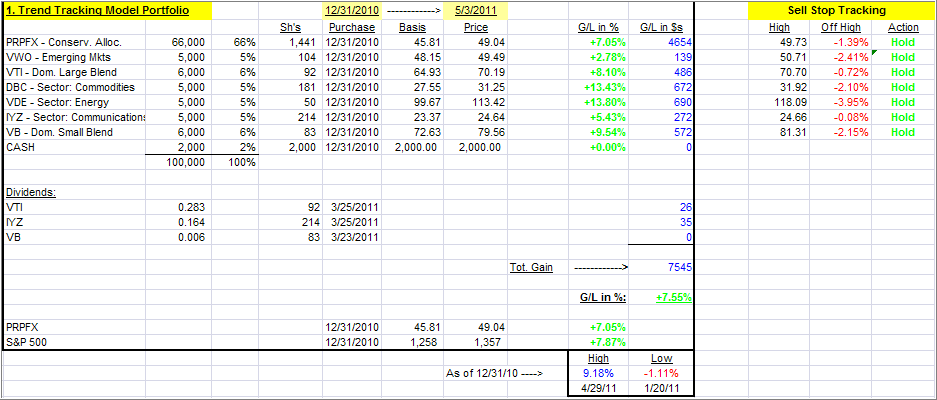
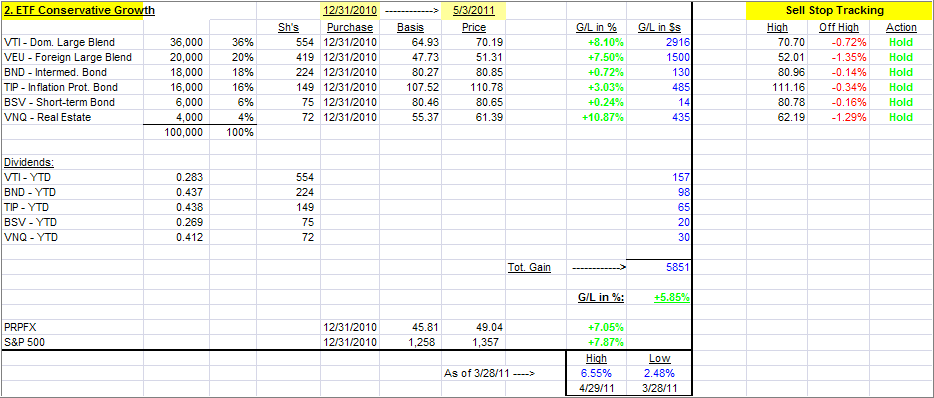
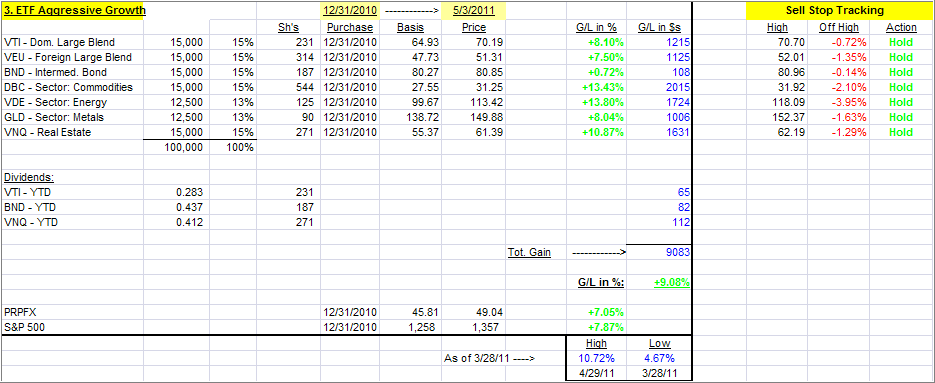
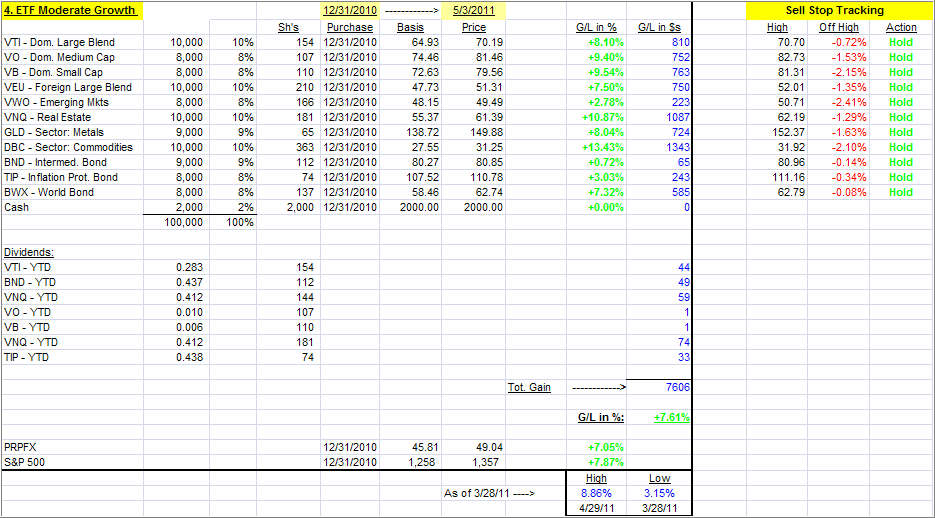
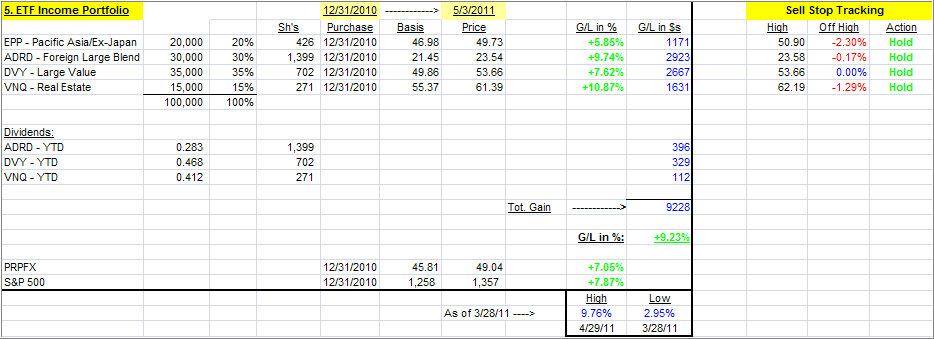
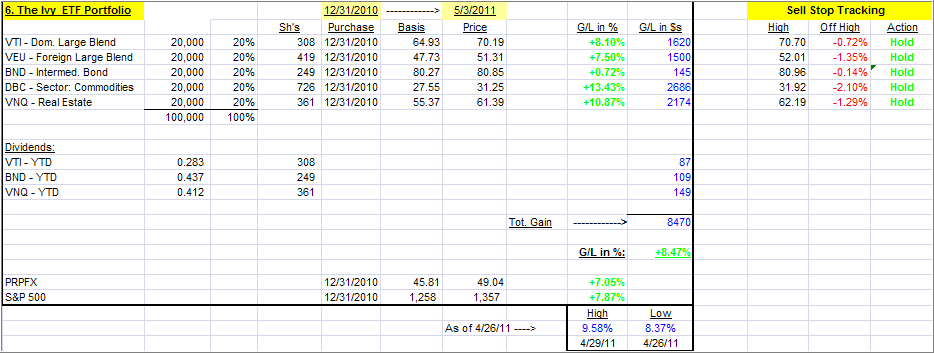
Comments 10
Hi Ulli:
Will you be seeling your holdings of VDE and DBC from portfolio 1? How should we handle a 6% decline of DBC in a single day?
Thanks.
Ulli: Posting in your website requires us to register and then use their password. Why can you not let people post anonymously without having to go through the registration. Thanks for your consideration.
Srini,
Depending on when you bought DBC, your 10% trailing sell stop may have been triggered. If so, see how market opens tomorrow. If DBC is up, hold it for another day, if it’s down, liquidate it. That will be my approach.
Ulli…
Hmm, as far as I know there is no registration requirement; it’s optional. I’ll double check with my programmer.
Ulli…
Ulli: One more question regarding sell stop rules.
To reduce the risk, if one wer to invest 50% of the target amount in an ETF and then wait for it to go up before investing the balance, when tracking sell stops:
Do you use two separate sell stops for each of the two investments in the same ETF? Or do you use the sell stop of the first investment to sell both the purchases.
Srini,
That is a good question. At first, these 2 sell stops will have separate trigger points. Eventually, if the markets continue to rally, the high point, from which to calculate the sell stops, will be the same. If this does not happen, I treat them as separate entities in regards to the sell stops.
Ulli…
Ulli,
First of all, great website!! Thanks for all the information, as I am a daily reader!
My question to you is about reinvesting dividends….What do you think? Should dividends be reinvested in the same ETF / fund, or put into a cash account?
Thanks!
Friedrich,
That is a personal decision. I for one have them deposited in cash and then reinvest once they have accumulated into a larger amount. That is especially important when investing within the confines of a 401k plan. Every investment, or reinvestment of dividends, counts as a trade and can subject you to a mutual fund’s trading restrictions.
Ulli…
Hello Uli,
I liked the idea of Conservative Portfolio 1 which is anchored in a low volatility fund PRPFX, which I have used with success previously, until its recent decline between April 29 through May 2 when it dropped 3.5% versus 2% approx. for the Dow and the S&P. It has a comparitively low beta and I have never seen it more volatile than the Dow. I’d appreciate your comments on why such a steady performer went off track so far so fast?
Dave,
The answer is simple. As gold and silver corrected, so did PRPFX, but it is making up lost ground quickly with the current rebound. Compare the PRPFX performance last month to the S&P: +4.58% vs. +2.87% respectively. There is bound to be a pick up in volatility even in a conservative allocation given certain market activity.
What is most important to me, since this buy cycle began on 6/3/09, PRPFX is the only fund out of all ETFs and mutual funds I monitior that did not trigger its trailing 7% sell stop.
Ulli…